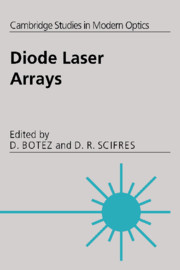Book contents
- Frontmatter
- Contents
- List of contributors
- Preface
- 1 Monolithic phase-locked semiconductor laser arrays
- 2 High-power coherent, semiconductor laser, master oscillator power amplifiers and amplifier arrays
- 3 Microoptical components applied to incoherent and coherent laser arrays
- 4 Modeling of diode laser arrays
- 5 Dynamics of coherent semiconductor laser arrays
- 6 High-average-power semiconductor laser arrays and laser array packaging with an emphasis on pumping solid state lasers
- 7 High-power diode laser arrays and their reliability
- 8 Strained layer quantum well heterostructure laser arrays
- 9 Vertical cavity surface-emitting laser arrays
- 10 Individually addressed arrays of diode lasers
- Index
8 - Strained layer quantum well heterostructure laser arrays
Published online by Cambridge University Press: 10 November 2009
- Frontmatter
- Contents
- List of contributors
- Preface
- 1 Monolithic phase-locked semiconductor laser arrays
- 2 High-power coherent, semiconductor laser, master oscillator power amplifiers and amplifier arrays
- 3 Microoptical components applied to incoherent and coherent laser arrays
- 4 Modeling of diode laser arrays
- 5 Dynamics of coherent semiconductor laser arrays
- 6 High-average-power semiconductor laser arrays and laser array packaging with an emphasis on pumping solid state lasers
- 7 High-power diode laser arrays and their reliability
- 8 Strained layer quantum well heterostructure laser arrays
- 9 Vertical cavity surface-emitting laser arrays
- 10 Individually addressed arrays of diode lasers
- Index
Summary
Introduction
The oldest, best developed, and still most sophisticated heterostructure materials system for semiconductor diode laser arrays is the AlGaAs—GaAs system. This system has a unique combination of practical physical, electrical, optical and chemical features that has withstood the test of time. These features include a tractable chemical system that lends itself equally well to basic epitaxial growth methods, such as liquid phase epitaxy (LPE), and to more sophisticated thin layer epitaxial growth methods, such as metalorganic chemical vapor deposition (MOCVD) and molecular beam epitaxy (MBE). Controlled thin layer epitaxy has, in turn, allowed the development of AlGaAs—GaAs quantum well heterostructure lasers. Perhaps the single most important attractive feature of the AlGaAs—GaAs heterostructure system is the fortunate coincidence that AlAs and GaAs have, for all practical purposes, the same lattice constant (Δa/a < 0.12%). This allows the design of any structure, with any combination of layer compositions, without regard to lattice mismatch or the associated dislocation formation.
The range of wavelengths available from lattice matched AlGaAs—GaAs conventional double-heterostructure lasers and quantum well heterostructure lasers is from λ ≈ 0.88–0.65 μm. The long wavelength limit is defined by the band edge for GaAs, and AlGaAs active layers or the quantum size effect, or both, are used to shift the emission to shorter wavelengths.
- Type
- Chapter
- Information
- Diode Laser Arrays , pp. 336 - 367Publisher: Cambridge University PressPrint publication year: 1994
- 1
- Cited by



